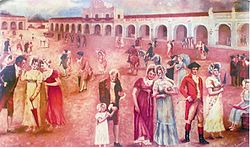Creole peoples
In the Middle ages, many Europeans were seafaring nations. They discovered new countries. Creole people are people who descended from people of different ethnic backgrounds. At the start, usually the father was European, and the mother was local. With time, whole societies of such people were formed.
There were three big groups:
- In the former Portuguese colonies, people mixed rapidly. The men often didn't find a woman of the same standing, so they married a slave. This meant that by default, their children would also be slaves. The men didn't want that, and many freed the woman they married (and their children). Such societies developed in Cape Verde, or in Brazil, for example. Today, these people are known as Crioulo.
- In the former Spanish colonies, things developed differently. Only the Spanish people born in the country could become bishop, or governor for example. The mixed people developed into a middle class, which gained a lot of influence. They are known as Criollo today.
- So-called Atlantic creoles traveled with the ships, mostly as translators. Very often one parent was European, the other was from Africa.
Since about the 18th century, the criollos make up the majority of people in many countries.
Creole Peoples Media
Trilingual signs on Cafe Kreol in Cape Verde.
An Aleutian man with an Alaskan Creole woman in the Aleutian Islands.
Free woman of color with mixed-race daughter; late 18th-century collage painting, New Orleans
Portrait of a Creole family in Sierra Leone, early 1900s.
Women at the Seychelles Creole Festival in Victoria celebrate their heritage.
Related pages
- Creole language, a language that is a mix of several languages







